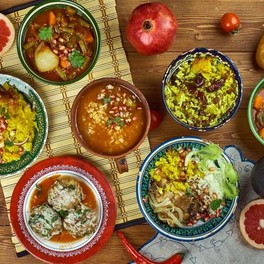What to Eat in Iran?
 What to Eat in Iran?
What to Eat in Iran?Iranian cuisine is one of the richest and most diverse in the Middle East, with a history spanning thousands of years. Iranian meals generally consist of rice, meat, and vegetables, and one of the most famous dishes is "Fesenjan", a chicken dish cooked with walnuts and pomegranate molasses. This dish represents the unique Iranian flavor that blends sweet and savory. Another dish, "Gheymeh", is a stew made with meat and peas, often served alongside kebabs.
Kebabs are incredibly popular in Iran and are typically made by grilling skewered meat over an open flame. These are often served with rice or flatbread. There are various types of kebabs throughout the country, but the "Koobideh" (minced meat kebab) is the most popular. Iranian dishes are known for being rich in spices. Common spices used in Iranian cuisine include saffron, turmeric, cumin, sumac, and a variety of mint.
While meat is a staple in Iranian cuisine, there are plenty of vegetarian options available. For example, "Khoresht-e Ghormeh Sabzi" is a dish made with spinach, parsley, and lamb, and is a common vegetarian choice. Another popular dish is "Tahchin", a mixture of rice, yogurt, and chicken that is baked to perfection. Iranian sweets are also diverse and delicious. While "Baklava" is well-known, "Saffron ice cream" is a must-try delicacy.
Different regions of Iran offer unique foods. For instance, seafood is popular in Southern Iran. The Hormuz Island region is particularly known for fresh fish and other seafood. In the North, dishes often feature ingredients like saffron and wild berries in their rice dishes. Iranian food culture is deeply intertwined with social life, and meals are often shared in large groups with family or friends.
Street food is also very popular in Iran. Items like "Sosisli Ekmek" (a type of sandwich with sausage), "Simit" (a sesame-crusted bread), and "Falyoud" (fried desserts) are commonly found in street markets, particularly during the mornings and evenings. Dining in Iran is not just about nourishment; it is a cultural experience and a social activity that brings people together, making mealtime an important part of everyday life.
Other Contents

